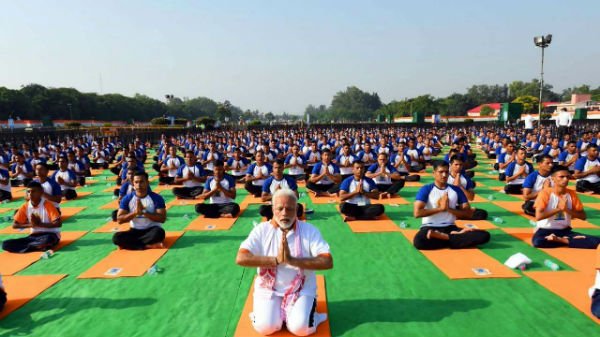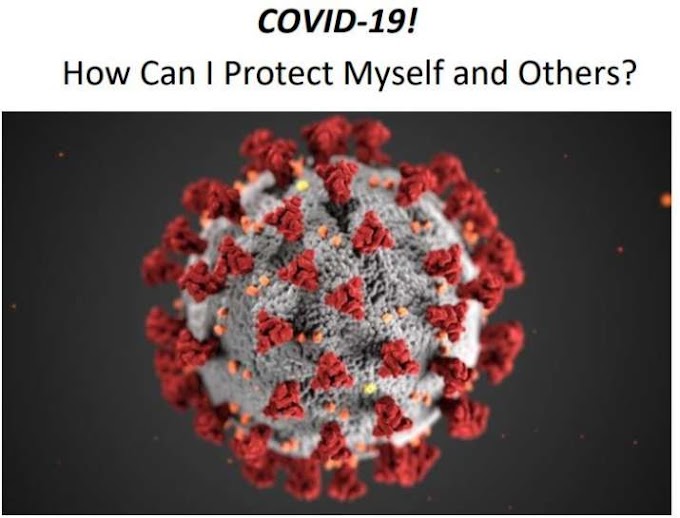 |
What is COVID-19 and how can I protect myself?
v Coronavirus
disease (COVID-19) is an infectious disease caused by a newly discovered
coronavirus.
v Most people
infected with the COVID-19 virus will experience mild to moderate respiratory
illness and recover without requiring special treatment. Older people,
and those with underlying medical problems like cardiovascular disease,
diabetes, chronic respiratory disease, and cancer are more likely to develop
serious illness.
v The best
way to prevent and slow down transmission is be well informed about the
COVID-19 virus, the disease it causes and how it spreads. Protect yourself and
others from infection by washing your hands or using an alcohol based rub
frequently and not touching your face.
v The
COVID-19 virus spreads primarily through droplets of saliva or discharge from
the nose when an infected person coughs or sneezes, so it’s important that you
also practice respiratory etiquette (for example, by coughing into a flexed
elbow).
v COVID-19 is
a new infectious disease caused by a strain of coronavirus (coronaviruses
are a large family of viruses that can cause different infections such as
common cold, but also SARS).
v The common
symptoms of COVID-19 include fever, dry cough, and tiredness, which can develop
into more serious symptoms later on.
Protecting
yourself and others from the spread COVID-19
v Regularly and thoroughly clean your hands with
an alcohol-based hand rub or wash them with soap and water. Why? Washing your
hands with soap and water or using alcohol-based hand rub kills viruses that
may be on your hands.
v Maintain at least 1 metre (3 feet) distance
between yourself and others. Why? When someone coughs, sneezes, or speaks they
spray small liquid droplets from their nose or mouth which may contain virus.
If you are too close, you can breathe in the droplets, including the COVID-19
virus if the person has the disease.
v Avoid going to crowded places. Why? Where
people come together in crowds, you are more likely to come into close contact
with someone that has COIVD-19 and it is more difficult to maintain physical
distance of 1 metre (3 feet).
v Avoid touching eyes, nose and mouth. Why?
Hands touch many surfaces and can pick up viruses. Once contaminated, hands can
transfer the virus to your eyes, nose or mouth. From there, the virus can enter
your body and infect you.
v Make sure you, and the people around you,
follow good respiratory hygiene. This means covering your mouth and nose with
your bent elbow or tissue when you cough or sneeze. Then dispose of the used
tissue immediately and wash your hands. Why? Droplets spread virus. By
following good respiratory hygiene, you protect the people around you from
viruses such as cold, flu and COVID-19.
v Stay home and self-isolate even with minor
symptoms such as cough, headache, mild fever, until you recover. Have someone
bring you supplies. If you need to leave your house, wear a mask to avoid
infecting others. Why? Avoiding contact with others will protect them from
possible COVID-19 and other viruses.
v If you have a fever, cough and difficulty
breathing, seek medical attention, but call by telephone in advance if possible
and follow the directions of your local health authority. Why? National and
local authorities will have the most up to date information on the situation in
your area. Calling in advance will allow your health care provider to quickly
direct you to the right health facility. This will also protect you and help
prevent spread of viruses and other infections.
v Keep up to date on the latest information from
trusted sources, such as WHO or your local and national health authorities.
Why? Local and national authorities are best placed to advise on what people in
your area should be doing to protect themselves.
However, in these testing times, it is important to not panic, and instead, maintain composure while practicing some important protection measures and taking up precautions when necessary. Here are 7 things you can do to stay safe:
Wash hands
frequently
ü
Hand hygiene is the most important factor in protecting yourself,
according to WHO. Wash your hands at least for 20 seconds frequently when you
have been in contact with multiple objects or in a crowded area. Make sure you
are scrubbing the back of your hands, between the fingers and under the nails.
Using regular soap and water is enough, and washing up to half your forearms is
recommended. In situations where you cannot do so, using alcohol-based hand
sanitizers is the next best option.
Do not touch your eyes, nose or mouth
ü
Your hands can pick up the virus from surfaces. Once
contaminated, the virus can enter your body when you touch your eyes, nose or
mouth. It would be advisable to avoid shaking hands and hugging people who may
be sick or may have returned from places where outbreaks have happened- it is
important to do so politely too.
Practice respiratory hygiene
ü
As mentioned before, the coronavirus infection spreads via
droplets of saliva and mucus. Practice good respiratory hygiene by covering
your face while coughing or sneezing into your elbow when in crowded places.
Make sure to dispose of used tissues or masks carefully.
Avoid crowded places
ü
Try not to be present in crowded places. If someone sneezes or
coughs, you may catch the virus since the droplets can levitate in the air
within several feet from the sneeze and for over 10 minutes. If travelling is a
must, then it is advised to steer clear of a sick person and wear a mask. WHO
has recommended avoiding non-essential travel to high-risk coronavirus-affected
countries. Always check the travel advisory before you proceed with any plans.
Wear a mask
ü
Not everyone needs to wear a mask. If you are a healthcare
provider, or if you are caring for an infected person, or if you are sick or
having symptoms, or if you are going to be amongst a large crowd, you need to
wear a mask to contain and prevent the spread of droplets. Do not
hoard masks as they are not foolproof methods to avoid catching the infection.
Remove the mask from the back of the head instead of touching it while
disposing.
Follow good personal hygiene
ü
Make sure you’re cleaning your house with disinfectant. Ensure
food is cooked properly. Avoid raw or under-cooked food. Avoid contact with
live animals, and if you do so, make sure you wash your hands thoroughly
afterwards.
ü
There is no evidence however of the infection spreading to
pets, but it would always be helpful to wash your hands frequently, especially
before and after contact with your pet, as a precaution.
Talk to a doctor
ü
If you are showing signs of fever, cough or breathing
difficulties, wear a mask and visit your doctor for a check up after informing
duly that you might be suspecting the infection. Additionally, if you have
these symptoms and have been in contact with someone who has the infection and
if you have returned from an area where an outbreak has occurred, it is
important to report to a helpline number dedicated to handling this, and then
visiting the nearest hospital as per instructions given.
To prevent infection and to slow transmission
of COVID-19, do the following:
v Wash your hands regularly with soap and water,
or clean them with alcohol-based hand rub.
v Maintain at least 1 meter distance between you
and people coughing or sneezing.
v Avoid touching your face.
v Cover your mouth and nose when coughing or
sneezing.
v Stay home if you feel unwell.
v Refrain from smoking and other activities that
weaken the lungs.
v Practice physical distancing by avoiding
unnecessary travel and staying away from large groups of people.
Symptoms of Covid-19
COVID-19
affects different people in different ways. Most infected people will develop
mild to moderate illness and recover without hospitalization.
Most common symptoms:
v fever.
v dry cough.
v tiredness.
Less common symptoms:
v aches and pains.
v sore throat.
v diarrhoea.
v conjunctivitis.
v headache.
v loss of taste or smell.
v a rash on skin, or discolouration of fingers
or toes.
Serious symptoms:
v difficulty breathing or shortness of breath.
v chest pain or pressure.
v loss of speech or movement.
Seek immediate medical attention if you have
serious symptoms. Always call before visiting your doctor or health
facility.
People with mild symptoms who are otherwise
healthy should manage their symptoms at home.
On average it takes 5–6 days from when someone
is infected with the virus for symptoms to show, however it can take up to 14
days.













0 Comments